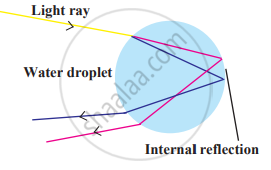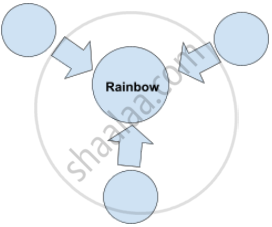Advertisements
Advertisements
प्रश्न
In an experiment to trace the path of a ray of light through a glass prism for different values of angle of incidence a student would find that the emergent ray:
(A) is parallel to the incident ray
(B) perpendicular to the incident ray
(C) is parallel to the refracted ray
(D) bends at an angle to the direction of incident ray
उत्तर
(D)
As the light gets refracted two times at different angles, the emergent ray bends at an angle to the direction of incident ray.
APPEARS IN
संबंधित प्रश्न
Describe an activity to show that colours of white light splitted by a glass prism can be recombined to get white light by another identical glass prism. Also draw ray diagram to show the recombination of the spectrum of white light.
Draw a ray diagram to explain the term angle of deviation.
Why do the component colours of incident white light split into a spectrum while passing through a glass prism, explain
Out of the following, the colour of light having the maximum wavelength is:
(a) violet
(b) indigo
(c) green
(d) orange
Out of air and glass, which is optically rarer? Give reason.
The frequency range of visible light is from 3.75 × 1014 Hz to 7.5 × 1014 Hz. Calculate its wavelength range. Take speed of light = 3 × 108 m/s.
An object is placed in front of a converging lens and in front of a diverging lens as in fig.

(a)Complete the ray diagram to obtain an image.
(b)Compare the nature of image formed by both the lenses in the above case.
Answer the following question:
Differentiate between a glass slab and a glass prism. What happens when a narrow beam of
(i) a monochromatic light, and
(ii) white light passes through
(a) glass slab and
(b) glass prism?
Distinguish between an impure spectrum and a pure spectrum.
Rainbow is a beautiful natural phenomenon. It is the combined effect of a natural three processes together produced by light. Write it into the circle.


